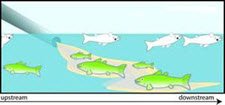Spatial/Temporal Co-occurrence
Concept
Spatial/Temporal Co-occurrence: The biological effect must be observed where and when the cause is observed, and must not be observed where and when the cause is absent.

Click for more information

Click for more information
Additional Illustrations of Spatial/Temporal Co-occurrence
Examples
Consider increased suspended solid concentrations as a candidate cause of reduced aquatic invertebrate abundance. What findings support or weaken the case for increased suspended solids as the cause, based on spatial/temporal co-occurrence?
- Supporting evidence (spatial co-occurrence) - Suspended solid concentrations are higher at the impaired site(s) than at unimpaired reference sites.
- Supporting evidence (temporal co-occurrence) - Suspended solid concentrations are episodic, and insect abundance decreases during periods with high suspended solids.
- Weakening evidence (spatial co-occurrence) - Suspended solid concentrations at the impaired site(s) are similar to those at unimpaired reference sites, or are greater at unimpaired reference sites than at the impaired site(s).
- Weakening evidence (temporal co-occurrence) - Suspended solid concentrations are episodic, and insect abundance increases or remains unchanged during periods with high suspended solids.
How Do I Analyze the Data?
Only measurements of the candidate causal agent (i.e., the proximate stressor) should be used to evaluate spatial/temporal co-occurrence: surrogate parameters or measurements of other steps in the causal pathway are considered under other types of evidence. Ideally, spatial and temporal associations should be determined from measures of the proximate stressor and the effect that are collected from the same locations on the same dates. Likewise, comparisons among sites should be made with data collected in a reasonably similar time frame, using similar methods.
For dichotomous stressors, analysis of co-occurrence is relatively straightforward: either the causal agent is found with the impairment or it is not. For example, the pathogen Myxobolus cerebralis, which causes whirling disease in trout, is either present or absent within a trout population. For continuous or count measures (e.g., chemical concentrations or percent of habitat affected), evaluation of co-occurrence is more difficult, and data analysis is needed to determine if stressor levels are elevated relative to unimpaired sites. When multiple samples are available at a given location, data should be summarized using a biologically relevant statistic. This statistic may be the arithmetic mean for stressors acting via chronic mechanisms, or an extreme value (e.g., minimum or maximum recorded concentration) for stressors acting through acute mechanisms.
More extensive information regarding statistical approaches that can support assessment of co-occurrence are available in the Data Analysis Volume.
Measurement error associated with the data will influence the confidence with which spatial/temporal co-occurrence can be determined. Analysis of co-occurrence also can be complicated by time lags between exposure to the stressor and manifestation of effects, as well as episodic stressor exposures. Each of these considerations should factor into evaluation of whether a candidate cause and the observed effect co-occur.
As with temporal sequence evidence, evidence of spatial/temporal co-occurrence should be evaluated with caution when multiple sufficient causes may be present, and when the objective of the analysis is to identify all contributing causes. For example, candidate causes occurring upstream may mask the effects of candidate causes occurring farther downstream, even though those candidates may be contributing to the observed effects.
What Evidence Would Support or Weaken the Case for a Candidate Cause?
- Data showing that where or when the candidate cause occurs, the effect occurs
- Data showing that where or when the candidate cause does not occur, the effect does not occur
- Data showing that where or when the candidate cause occurs, the effect does not occur
- Data showing that where or when the candidate cause does not occur, the effect occurs
- Data showing, with a high degree of certainty, that the candidate cause was never present
How Do I Score the Evidence?
| Finding | Interpretation | Score |
|---|---|---|
| The effect occurs where or when the candidate cause occurs, OR the effect does not occur where or when the candidate cause does not occur. | This finding somewhat supports the case for the candidate cause, but is not strongly supportive because the association could be coincidental. | + |
| It is uncertain whether the candidate cause and the effect co-occur. | This finding neither supports nor weakens the case for the candidate cause, because the evidence is ambiguous. | 0 |
| The effect does not occur where or when the candidate cause occurs, OR the effect occurs where or when the candidate cause does not occur. | This finding convincingly weakens the case for the candidate cause, because causes must co-occur with their effects. | --- |
| The effect does not occur where and when the candidate cause occurs, OR the effect occurs where or when the candidate cause does not occur, and the evidence is indisputable. | This finding refutes the case for the candidate cause, because causes must co-occur with their effects. | R |
Helpful Tips
- Only co-occurrence of the candidate cause and the effect is evaluated under spatial-temporal co-occurrence; whether the magnitude of the stressor is sufficient to cause the effect is evaluated later.
- Temporal co-occurrence is considered less often than spatial co-occurrence at a given time. When temporal co-occurrence is considered, lags between the onset of exposure and the observation of effects, and between the end of exposure and recovery from effects, must be taken into account.
- Temporal co-occurrence differs from temporal sequence in that it is not concerned with whether the candidate cause or the effect came first, but only with the fact that both the candidate agent and the effect are present.
